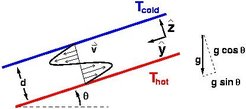Inclined Layer Convection
Rayleigh-Bénard convection (RBC) of a horizontal fluid layer heated from below has long served as a model for pattern forming systems. Variations that alter the symmetries, such as rotation around a vertical axis and vertical vibrations continue to lead to new important insights. Another case, of particular meteorological and oceanographic interest, is RBC of a fluid layer inclined with respect to gravity. This system is not only well suited for the study of buoyancy and shear flow driven instabilities, but may also serve, along with liquid crystal convection, as a paradigm for anisotropic pattern forming systems.

As with RBC, the onset of inclined layer convection (ILC) occurs when the temperature difference across the layer is sufficient for convection rolls to form. The main difference from RBC is that here the convectionless base state also contains symmetry-breaking shear flow. The component of gravity tangential to the layer causes fluid to flow up along the warm plate and down along the cold plate. For small angles, the normal component of gravity determines the onset of longitudinal rolls (axis aligned with the shear flow direction), while for inclination angles close to and above 90°, transverse rolls are predicted to be the linear mode of instability. The few prior experiments showed reasonable agreement with linear theory for inclination angles smaller than 90°. While these experiments showed qualitatively that longitudinal rolls were unstable to undulations, the investigations were limited by aspect-ratio (width:height) and experimental methods of visualization.
We have performed experiments on ILC in convection cells of large aspect-ratio for a fluid with Prandtl number σ ≈ 1 for inclination angles 0° < θ < 120°. We observed a number of unpredicted nonlinear states: at small angles of inclination we found subharmonic traveling waves, oscillatory longitudinal rolls, undulation chaos, and crawling rolls. At larger angles (in the vicinity of the codimension two point for thermal and shear driven instability) we observed drifting transverse rolls, localized bursts and bimodal patterns. With an increase of angle past 90° (so that the cell is heated from above), a novel spatio temporal chaotic state of switching diamond pane rolls was observed. Many of these novel spatio-temporal chaotic states are found very close to onset where theoretical progress have been possible as well. Movies of these experimental states and their corresponding simulations can be found on our movie page.
